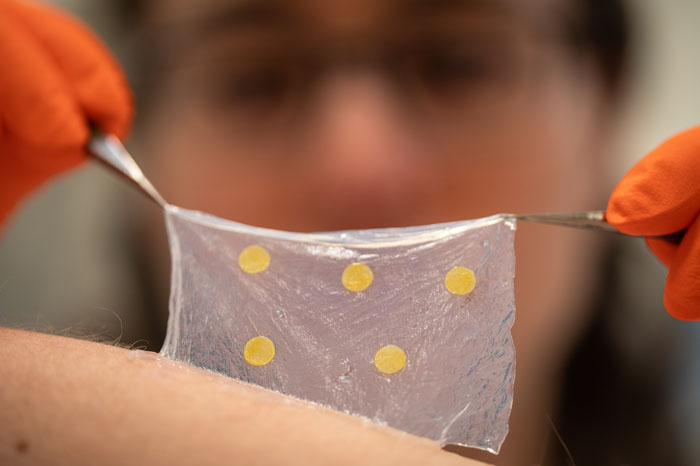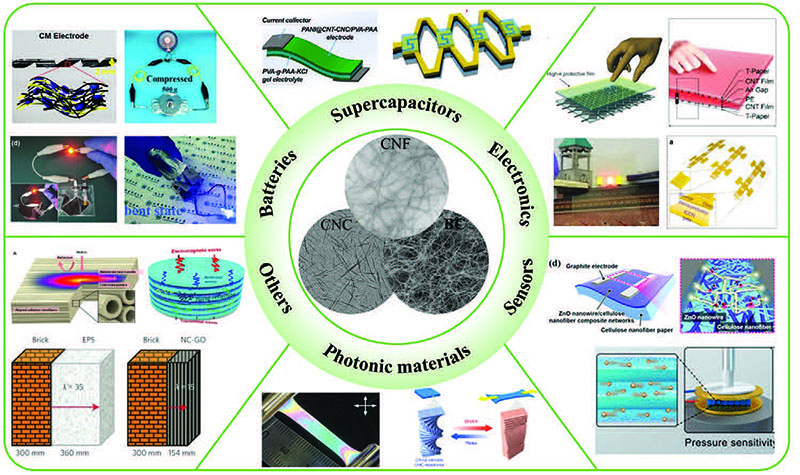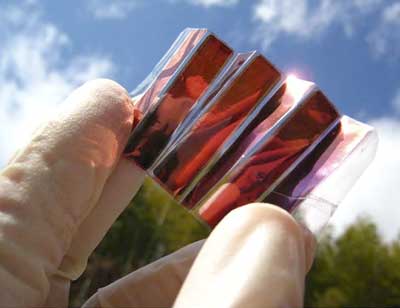| May 16, 2023 | |
Advanced flexible materials made from nanocellulose |
|
| (Nanowerk Spotlight) Nanocellulose, a specialized type of cellulose processed to create nanoscale fibers, represents a significant advancement in the materials industry. These fibers possess remarkable properties such as high strength, low weight, excellent biocompatibility, and efficient water retention, which makes them a standout candidate for numerous applications. The production of nanocellulose is a complex process that involves mechanically or chemically breaking down cellulose fibers, derived from various sources including wood, agricultural waste, and bacteria, into individual nanofibrils. | |
| These nanoscale fibers exhibit exceptional strength, even when extremely thin, making them suitable for applications where strength and lightweight properties are of significant importance. Particularly, industries focused on electronics and energy storage can greatly benefit from these properties. Further, the low weight of nanocellulose fibers makes them an ideal choice for applications where weight is a primary concern, such as wearable electronics and implantable medical devices. | |
| The biocompatibility of nanocellulose signifies its safety when in contact with living tissue. This unique characteristic earmarks nanocellulose as a promising material for various biomedical applications, such as tissue engineering and drug delivery. For instance, researchers have demonstrated nanocellulose wound dressing that can reveal infection. | |
 |
|
| A nanocellulose wound dressing that can reveal early signs of infection through a shift in colour. (Image: Olov Planthaber) | |
| Beyond this, nanocellulose fibers display a high affinity for water, which makes them beneficial for applications dealing with water management, including food packaging and water purification. Additionally, their excellent barrier properties to gases and liquids make them useful for applications needing protection from environmental factors, such as in food packaging and batteries. From a sustainability perspective, nanocellulose is a valuable material as it can be produced from renewable resources. | |
| A recent review in Advanced Functional Materials ("Advanced Flexible Materials from Nanocellulose") comprehensively summarizes the recent advances of nanocellulose-based materials in various applications. Specifically, it provides a detailed overview of the latest progress in the design, fabrication, and applications of nanocellulose-based flexible materials – including aspects of compressibility, bendability, foldability, twisting, and stretchability | |
| The versatile nature of nanocellulose has found its way into the electronics industry, where it is used to fabricate flexible electrodes, transistors, and other electronic components. This contributes to the development of a new wave of electronic devices, such as flexible displays, wearable electronics, and implantable medical devices. In the realm of energy storage, the application of nanocellulose has led to the development of flexible, light, and thin batteries and supercapacitors, which outperform their traditional counterparts. Such innovations carry the potential to fundamentally alter the way energy storage is perceived and managed. | |
 |
|
| Overview of using nanocellulose as a building block for fabricating flexible materials in different forms, and their potential applications in various fields. (Reprinted with permission from Wiley-VCH Verlag) (click on image to enlarge) | |
| Biomedical applications of nanocellulose are particularly promising. Nanocellulose-based films and membranes have been developed that can be used to repair damaged tissues and organs. Notably, these materials are under investigation for their potential use in drug delivery and tissue engineering. | |
| Despite the impressive array of applications and advantages, the development of nanocellulose-based flexible materials is still in its nascent stages. There are significant challenges that need to be addressed before these materials can be widely adopted. Notably, nanocellulose is currently relatively expensive to produce, which is a significant barrier to its widespread adoption. The scalability of production is another considerable challenge, as current production methods are not equipped to meet the demands of large-scale production. Additionally, the stability of nanocellulose is a concern, as it is a highly sensitive material that can degrade easily. This poses a substantial challenge to the development of durable, long-lasting nanocellulose-based materials. | |
| Efforts are ongoing to overcome these challenges. Current research is focused on developing more efficient and cost-effective methods for producing nanocellulose. Additionally, researchers are working on methods for scaling up nanocellulose production to meet the demands of large-scale production. Other efforts are directed towards finding ways to stabilize nanocellulose, to make it more durable and long-lasting. | |
| Despite these hurdles, the potential of nanocellulose-based flexible materials is enormous. With continued research and development, nanocellulose has the potential to revolutionize a broad range of industries, including electronics, energy storage, and biomedical devices. This innovative material offers a myriad of possibilities for the future of flexible materials. | |
| One of the promising arenas for nanocellulose is in the electronics industry. The strength and low weight of nanocellulose fibers make them ideal for creating flexible electronic components, such as electrodes and transistors. When integrated into electronic devices, these components can lead to the development of flexible displays, wearable electronics, and even implantable medical devices that could revolutionize the way we interact with technology. | |
| In proof-of-concept work, researchers already have demonstrated a nanocellulose paper semiconductor and a conductive nanopaper out of nanocellulose and silver nanowires that could be used for flexible electronics and solar cells. | |
 |
|
| Portable solar cells based on foldable, lightweight, transparent, conductive cellulose nanofibre paper. (Image: CC-BY Macmillan Publishers Ltd) | |
| Another significant area where nanocellulose shows immense potential is energy storage. Lighter, thinner, and more flexible than traditional energy storage devices, nanocellulose-based batteries and supercapacitors have the potential to redefine energy storage. These advanced energy storage devices can open up new possibilities in a variety of sectors, from consumer electronics to electric vehicles, and can even contribute to more efficient utilization of renewable energy sources. | |
| In the biomedical field, nanocellulose is finding applications in a variety of innovative ways. Due to its excellent biocompatibility, it can be used to create films and membranes that help repair damaged tissues and organs. These materials are also being explored for their potential in drug delivery systems and tissue engineering, offering new avenues in medical treatment and recovery processes. | |
| Nanocellulose also has applications in the fields of food packaging, water purification, construction, transportation, and aerospace. For instance, its high water retention and excellent barrier properties make it useful for creating more efficient and sustainable food packaging. For instnce, researchers have created a manufacturing process using cellulose nanocrystals as advanced barrier coatings for food packaging. | |
| In water purification, nanocellulose can serve as a material for filters to remove pollutants, potentially improving the quality of drinking water and reducing the risk of waterborne diseases. Its high strength and low weight can also contribute to the construction of more durable and fuel-efficient tires in transportation, and lighter and stronger parts in the aerospace industry. | |
| While the potential applications of nanocellulose are vast, there are still significant challenges to overcome. The production cost, scalability of production, and stability of nanocellulose are key issues that need to be addressed. Currently, the production of nanocellulose is relatively expensive, posing a major barrier to its widespread adoption. The methods for producing nanocellulose are also not yet scalable to meet the demands of large-scale production. In addition, nanocellulose is a highly sensitive material that can degrade easily, posing a challenge for the development of durable, long-lasting nanocellulose-based materials. | |
| Despite these challenges, the potential of nanocellulose is undeniable. With continued research and development, new and more efficient methods for producing nanocellulose are being explored. These include efforts to make the production process more cost-effective, scalable, and capable of producing more durable and stable nanocellulose. As these challenges are addressed, the future of nanocellulose in the materials industry looks promising. Its potential to revolutionize a variety of sectors from electronics to biomedical devices suggests that nanocellulose-based flexible materials could soon become a mainstay in our lives and work. | |
 By
Michael
Berger
– Michael is author of three books by the Royal Society of Chemistry:
Nano-Society: Pushing the Boundaries of Technology,
Nanotechnology: The Future is Tiny, and
Nanoengineering: The Skills and Tools Making Technology Invisible
Copyright ©
Nanowerk LLC
By
Michael
Berger
– Michael is author of three books by the Royal Society of Chemistry:
Nano-Society: Pushing the Boundaries of Technology,
Nanotechnology: The Future is Tiny, and
Nanoengineering: The Skills and Tools Making Technology Invisible
Copyright ©
Nanowerk LLC
|
|
|
Become a Spotlight guest author! Join our large and growing group of guest contributors. Have you just published a scientific paper or have other exciting developments to share with the nanotechnology community? Here is how to publish on nanowerk.com. |
|
